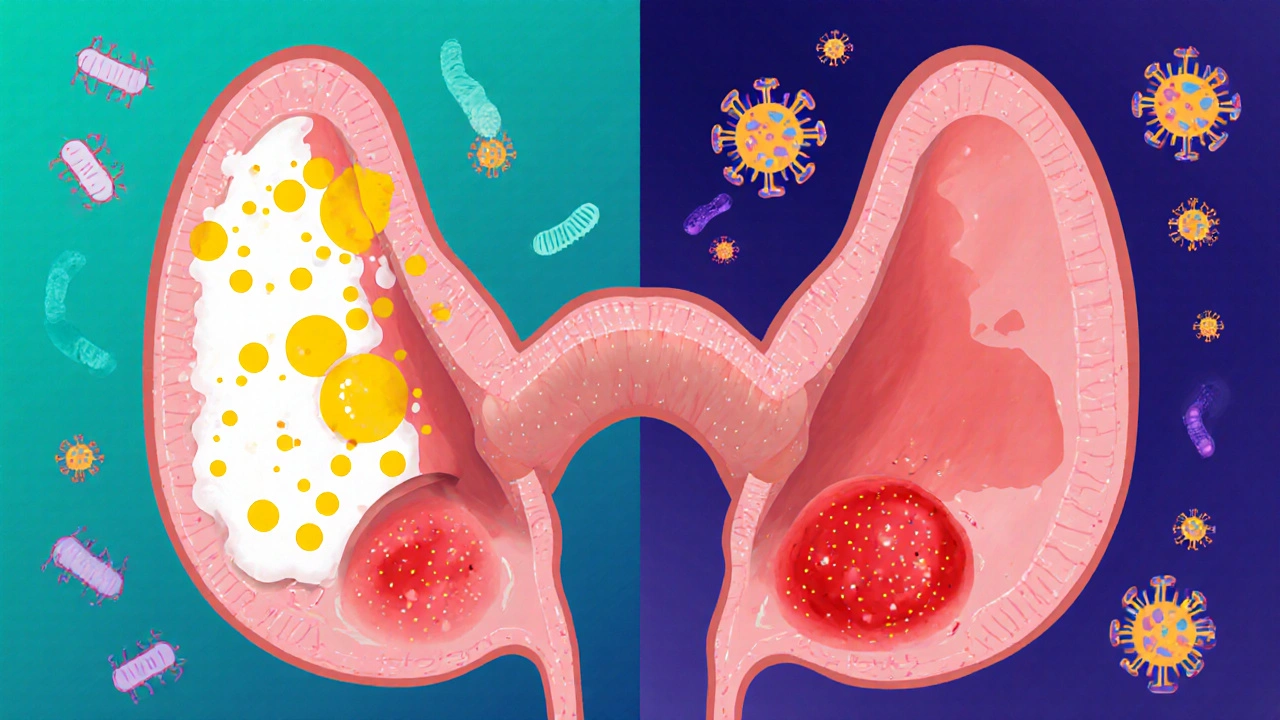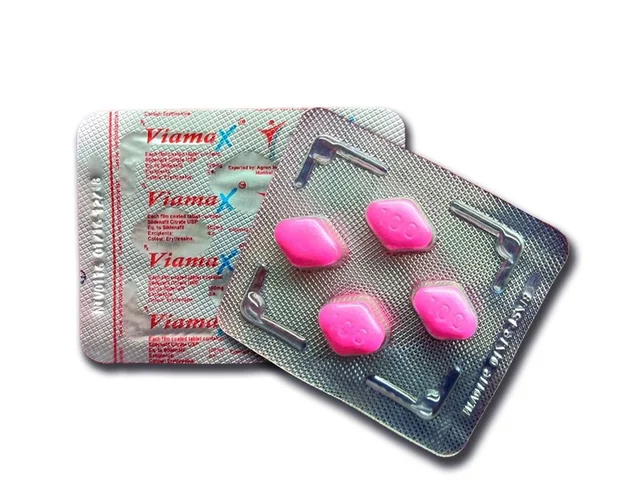Tonsillitis & Swollen Glands Symptom Checker
Check Your Symptoms
Answer the following questions to assess your condition and get personalized recommendations.
Your Symptom Analysis
When your throat hurts and you feel a lump on the side of your neck, you’re likely dealing with two things that often travel together: tonsillitis and swollen glands. Understanding why they appear together helps you know when to rest at home and when a doctor’s visit is needed.
Key Takeaways
- Tonsillitis is an inflammation of the tonsils that frequently triggers swelling of nearby lymph nodes (swollen glands).
- Bacterial causes, especially group A Streptococcus a genus of bacteria, with group A Streptococcus being a common cause of tonsillitis, require antibiotics; viral causes do not.
- Typical symptoms include sore throat, fever, and tender neck nodes, but the exact pattern can hint at the underlying pathogen.
- Quick at‑home care-hydration, pain management, and rest-works for most viral cases, while bacterial cases improve faster with a prescribed course of Antibiotics medicines that kill or stop bacterial growth.
- If glands stay swollen for more than two weeks, or you develop difficulty breathing, seek medical attention promptly.
What Is Tonsillitis?
Tonsillitis is a inflammation of the tonsils, the two lymphoid tissues at the back of the throat. The tonsils act as the first line of defense, catching germs that enter through the mouth or nose. When they get infected, blood flow increases, causing redness, swelling, and pain.
What Does It Mean When Glands Swell?
Swollen Glands refers to enlarged lymph nodes, often felt in the neck during infections. Lymph nodes are small, bean‑shaped structures that filter fluid and trap microbes. They sit in clusters along the neck, under the jaw, and behind the ears. When they detect an infection, they swell as immune cells rush in to fight off the invaders.

How the Immune System Connects Them
The link between tonsillitis and swollen glands is the immune system the body's defense network that fights pathogens. When the tonsils become inflamed, the nearby lymph nodes small bean‑shaped structures that filter lymph fluid and trap germs receive a flood of immune cells. This triggers the nodes to enlarge, which you feel as tender lumps on the side of your neck.
Common Causes: Bacterial vs. Viral
Most sore throats are viral, but about 30% are caused by bacteria. Knowing the type matters because it decides whether antibiotics are needed.
| Aspect | Bacterial Infection | Viral Infection |
|---|---|---|
| Typical Agent | Bacterial infection an invasion by bacteria such as Streptococcus pyogenes | Viral infection illness caused by viruses like adenovirus or influenza |
| Onset | Sudden, often high fever (≥101°F) | Gradual, low‑grade fever or none |
| Pus on Tonsils | Common, white or yellow spots | Rare, usually red inflammation only |
| Swollen Glands | Marked, tender, often unilateral | Generally milder, may be bilateral |
| Treatment | Course of Antibiotics medicines that kill or stop bacterial growth | Supportive care only (fluids, rest, Pain management strategies like acetaminophen or ibuprofen to ease throat pain) |
Symptoms Overlap and Differences
- Sore throat - present in both, often worse with swallowing.
- Fever - high in bacterial cases, low or absent in many viral cases.
- White patches - thick white coating points toward bacterial infection.
- Swollen, tender neck nodes - can be severe with bacterial tonsillitis, mild to moderate with viral.
- Bad breath - more common when pus is present.
Getting a Proper Diagnosis
Doctors rely on a quick visual exam and a rapid strep test. The test swabs the throat, mixes it with a reagent, and changes color if group A Streptococcus a genus of bacteria, with group A Streptococcus being a common cause of tonsillitis is present. If the test is negative but symptoms stay severe, a throat culture may be ordered, which takes 24-48hours.

Treatment Options
Regardless of cause, the first goal is to ease pain and keep you hydrated.
- Hydration: Warm broths, herbal teas, and plenty of water keep the throat moist.
- Heat or cold packs: Applying a warm compress to the neck can reduce node tenderness.
- Over‑the‑counter meds: Pain management (acetaminophen or ibuprofen) lowers fever and dulls throat pain.
If a bacterial agent is confirmed, a full 10‑day course of Antibiotics (usually penicillin or amoxicillin) is prescribed. Stopping early can lead to recurrent infections or rare complications like rheumatic fever.
For viral cases, rest, humidified air, and the measures above are all you need. Symptoms usually improve within 5-7days.
When Swollen Glands May Signal Something Else
Most swollen glands from tonsillitis shrink within two weeks. However, persistent enlargement raises red flags:
- Nodes that feel hard, immobile, or grow larger over time.
- Weight loss, night sweats, or unexplained fatigue.
- Difficulty breathing or swallowing.
These could indicate mononucleosis, a bacterial abscess, or even early lymphoma. A doctor may order blood tests, imaging, or a biopsy to rule out serious conditions.
Prevention Tips
- Wash hands frequently, especially after being in crowds.
- Avoid sharing utensils, drinking glasses, or toothbrushes.
- Stay up to date on the flu vaccine; it reduces viral throat infections.
- Consider a daily probiotic if you frequently get antibiotics-helps restore healthy throat flora.
Quick FAQ
Can tonsillitis cause permanent swelling of the glands?
Usually not. Once the infection clears, the lymph nodes shrink back to normal size within a couple of weeks. Persistent swelling warrants a doctor’s review.
When should I get tested for strep?
If you have a sudden high fever, white patches on the tonsils, and painful neck nodes, a rapid strep test is advisable. Early testing speeds up treatment.
Are over‑the‑counter lozenges effective?
Lozenges can temporarily soothe the throat, but they don’t address the underlying infection. Pair them with fluids and pain relievers for best relief.
Can I eat solid foods with tonsillitis?
Soft, easy‑to‑swallow foods like soup, yogurt, and mashed potatoes are safest. Crunchy or acidic foods can worsen irritation.
Do antibiotics work for viral tonsillitis?
No. Antibiotics target bacteria only. Using them for a viral infection can cause side effects and contribute to antibiotic resistance.
Understanding the dance between tonsillitis and swollen glands lets you respond quickly, keep the pain manageable, and know when professional care is essential. Stay hydrated, watch your symptoms, and don’t hesitate to seek medical advice if anything feels off.








9 Comments
Angie Robinson October 6, 2025
Anyone who relies on a generic symptom checker obviously isn’t serious about health.
Emmons Kimery October 18, 2025
Hey folks, this checker is a handy starting point! 😊 It can flag when you might need a doc, but always trust a professional for a full exam. 👍 Stay hydrated and rest up.
Mimi Saki October 28, 2025
Feeling under the weather? Remember, most sore throats are viral and get better with fluids and rest. 🌟 Keep an eye on fever and don’t hesitate to call your doctor if it spikes.
Subramaniam Sankaranarayanan November 11, 2025
Tonsillitis is an inflammation of the palatine tonsils, most frequently caused by viral agents such as adenovirus, influenza, or Epstein‑Barr virus.
Bacterial etiologies, primarily Group A Streptococcus, account for a significant minority and demand antibiotic therapy.
The pathophysiology involves mucosal edema, leukocyte infiltration, and often the formation of exudative plaques on the tonsillar surface.
Clinically, patients present with sore throat, dysphagia, and odynophagia, which may be accompanied by fever exceeding 101 °F.
Cervical lymphadenopathy is a hallmark physical finding, reflecting reactive hyperplasia of regional nodes.
In pediatric populations, the threshold for antimicrobial intervention is lower due to a higher risk of complications such as peritonsillar abscess.
Diagnostic confirmation of streptococcal infection relies on rapid antigen detection tests or throat culture, both of which should be performed before prescribing penicillin or amoxicillin.
Empirical treatment without confirmation can contribute to antimicrobial resistance, a public health concern that must not be dismissed lightly.
Symptomatic management includes analgesics like acetaminophen or ibuprofen, alongside adequate hydration and humidified air.
Adjunctive measures such as gargling warm saline solutions can provide modest relief by reducing mucosal inflammation.
If ulcerative lesions, persistent high fever, or airway compromise develop, urgent otolaryngology referral is warranted.
Chronic or recurrent tonsillitis may justify tonsillectomy, particularly when quality‑of‑life metrics degrade significantly.
Post‑operative considerations involve pain control, monitoring for hemorrhage, and a short period of dietary modification.
Ultimately, the decision matrix balances etiologic certainty, symptom severity, patient age, and comorbid conditions.
Therefore, while symptom checkers are useful triage tools, they cannot replace comprehensive clinical evaluation.
Kylie Holmes November 13, 2025
Great rundown! If you’re feeling that intense, don’t wait-see a doc ASAP!
Jennifer Wees-Schkade November 23, 2025
From a clinical standpoint, the presence of high fever and exudates warrants a rapid strep test; pending results, a short course of penicillin is usually sufficient. Additionally, supportive care-hydration, throat lozenges, and NSAIDs-can alleviate discomfort while awaiting confirmation.
Fr. Chuck Bradley November 24, 2025
Whoa, drama alert! Imagine the horror of a sore throat turning into a full‑blown emergency-no one wants that nightmare.
mike brown December 1, 2025
Honestly, all this “expert advice” is just common sense dressed up in fancy words. Americans need to stop over‑medicalizing every cold.
shawn micheal December 3, 2025
Hey, keep the optimism flowing! Even if it’s just a cold, staying positive and getting enough rest speeds up recovery. Let’s not forget the power of vitamin C and warm tea.